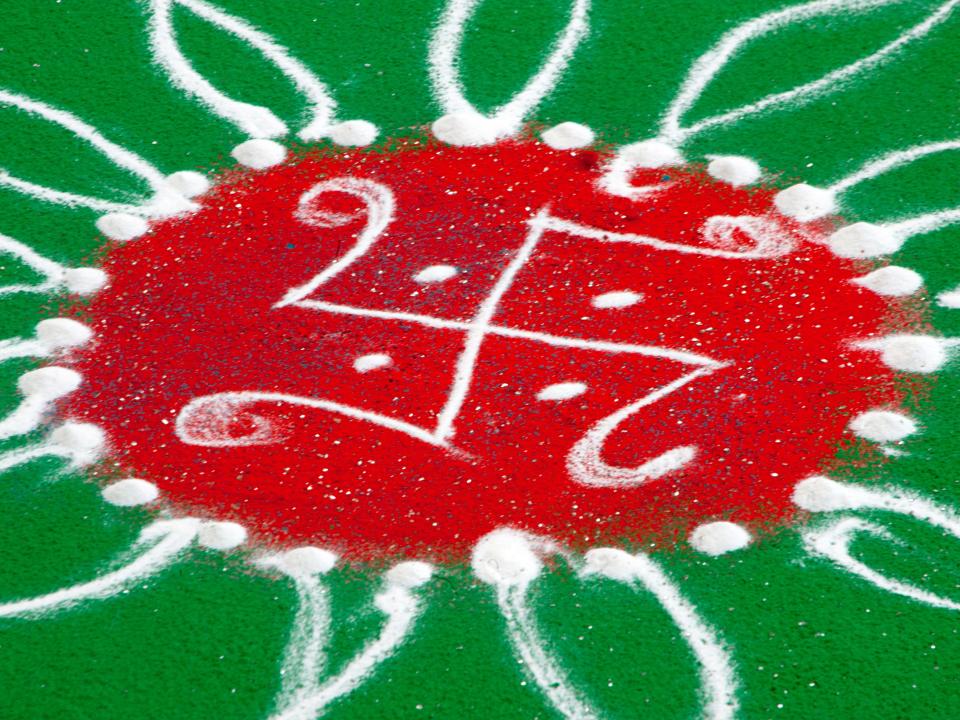The history of the swastika: From a sign of luck and fortune to a symbol of evil

The swastika is now an infamous sign of hatred, extremism, and genocide.
But it has a long history and has been used by cultures worldwide to signify good fortune and luck.
Carlsberg and Finnish Air used it in their branding before the Nazis hijacked it.
Last week, historians in Denmark announced they had discovered the oldest evidence of people worshipping the Norse god of war and death, Odin.
Next to the portrait of Odin was a small swastika-like sign, once a signifier of peace, wealth, and fortune.
Today, the swastika is seen by many as a symbol of hatred, extremism, and danger. But it has a long and diverse history that stretches way beyond its cruel co-option by Adolf Hitler and the German Nazi party a century ago.
The origins of the swastika
The word swastika comes from the Sanskrit word svastika, which translates to "good fortune" or "wellbeing."
The oldest known use of the swastika is seen on a 15,000-year-old mammoth ivory bird statue discovered in 1908 by Ukrainian scientist Federik Volkov.
On the chest of the bird, held in The National Museum of the History of Ukraine, Kyiv, is an engraving of joined-up swastikas, according to the BBC. The statue was discovered alongside a range of "phallic objects," suggesting the swastika was used as a good luck symbol to invite fertility.
The swastika in Asia
Today, the swastika is still widely used in a number of Indian religions.
In Jainism, the swastika represents the four states of existence: Heavenly beings, Human beings, Hellish beings, and subhuman life.
In the Zoroastrian faith, one of the world's oldest religions, the four prongs of the swastika represent water, fire, air, and earth.
And in Buddhism, the sign is used to represent Buddha's footsteps, known as manji.

Across India, the symbol is seen on shop doors, vehicles, food packaging, and at festivals, according to AP.
It has also been adopted in other parts of Asia. In China, the symbol is known aswàn and was declared the "source of all good fortune" by Empress Wu in 693. The use of the swastika alongside a wish multiplies that wish 10,000 times, according to the Pacific Asia Museum.
Swastika in Europe
Worshipers of the Norse religion used the swastika symbol as early as 401 AD.
Most commonly, the symbol is seen next to depictions of Thor, the Norse god of thunder, the sky, and agriculture. It is also seen next to his father, Odin.
But it wasn't just Nordic people that were using the swastika. The symbol is known to have been used by Celts, Druids, and Vikings.
US art director Steven Heller, author of "Swastika: Symbol Beyond Redemption?" told the BBC that the swastika was used in Europe to manifest good luck until the early 20th century. "The sign was used in many ways before Hitler adapted it. A sign of good fortune, fertility, happiness, Sun, and it was given spiritual import as well as commercial value when it was used with or as a brand or logo," said Heller.

Less than 100 years ago, many companies used the symbol in their branding. The beer company Carlsberg had it on its logo, as did the Finnish Air Force and even the British Boy Scouts.
However, that all started to change in the 1920s.
Co-opted by the Nazis
Some researchers believe that people of Aryan culture used the symbol as a sign of luck and prosperity.
Aryanism is often linked to a belief in racial purity, but "Aryans" were originally Indo-European or Indo-Germanic people who settled throughout India, Iran (then known as Persia), and Europe, according to the United States Holocaust Museum.
The classification of Aryanism was often used to refer to the shared languages used within the culture, but later it shifted to be used as a racial categorization.
The BBC reports that the similarity in these languages to German is thought to have influenced Hitler's belief that the Aryans – especially those from India – and Germans had a "pure" lineage.
Another theory is that Hitler would have simply seen the symbol repeatedly growing up.
After Hitler's Nazi Party chose the swastika as its official symbol in 1920, it slowly became identified with racial purity, extremism, and totalitarian terror, a long way from its roots as an emblem of good fortune.
When the Nazi Party took power over Germany in 1933, Hitler decreed that the German state flag had to be flown alongside the now-infamous red flag that boasts a huge black swastika.
Today, the once-innocent swastika is now considered an incarnation of evil representing genocide, gas chambers, and the millions murdered in the Holocaust.
But some are trying to change that. They don't want people to forget the atrocities of Hitler's Third Reich but do want to revive the wide cultural significance of the swastika.

In 2022, Sheetal Deo, from New York – which has a population of 1.6 million Jews – told AP that she was asked to remove her Diwali decor, the Hindu festival of lights, displayed at her Queens apartment building, which had a swastika on it.
She told AP that she does not believe she should have to apologize for a sacred symbol simply because it is often conflated with its tainted version, saying doing so is "intolerable."
But Steven Heller told AP, "A rose by any other name is a rose. In the end, it's how a symbol affects you visually and emotionally. For many, it creates a visceral impact, and that's a fact."
Read the original article on Business Insider

 Yahoo Finance
Yahoo Finance 